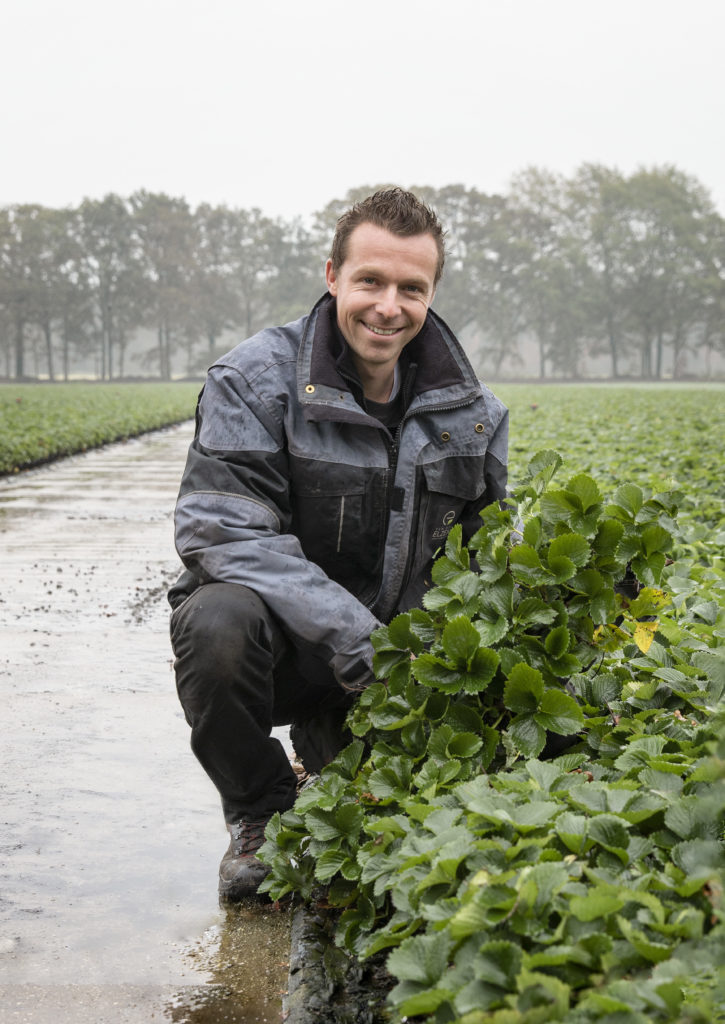Raspberries, strawberries and asparagus. These are the three pillars of van den Elzen in Erp. In the pouring rain, production manager Bart van Eerdt shows us strawberries plants on the tray
field. These plants will soon be taken to cold storage before being shipped to customers throughout Europe and beyond. The same applies to the asparagus plants and long cane raspberry plants. From small beginnings, van den Elzen has evolved into a major producer with locations in Erp and Maasbree. To safeguard the best plant material, the nursery works with five propagation companies and manages a large collection of mother plants.
Expansion
Van den Elzen responded to growth in the soft fruit sector in good time. Last spring the company acquired a 43-hectare site in Maasbree, in the neighbouring province of Limburg. On that site,
25 hectares of land was quickly prepared for raspberry cane cultivation. There are plenty of plans for the rest of the plot, including constructing greenhouses to house the mother plant collection
and provide space to propagate young cuttings. This will enable some of cultivation activities to take place under controlled conditions, so the basic plant material is guaranteed disease-free.
The company’s massive expansion is needed to serve the market, as customers are also growing. ‘So we are scaling up too. We want to stay distinctive and innovative. Our strength is service and quality’, explains Van Eerdt.

Long-term planning
Supplying plant material requires a long, advance planning. ‘Our strategy is demand-driven production’, he says. ‘95% of the plant material has already been sold before the first cuttings are even planted. To give an impression: we are currently selling plants that will be delivered in 2021.’ A little cutting planted in July grows into a tray plant and is put into the cold store in mid-December. Keeping the strawberry plants in cold conditions means they can be stored and delivered until August of the following year. Growing raspberries is also time consuming. In May, the propagator plants the young plug plants. During the growing year, these small plants grow into long canes. In autumn, the plants are taken to the cold store where they are exposed to enough cold hours to ensure they start growing on again properly at the customer’s premises. Van den Elzen then delivers the canes, depending on the cultivation planning. 90% of the raspberry plants are exported, to production regions in Spain, Italy and Morocco.
Peak delivery times
The peak times for substrate deliveries are spring and June. Van Eerdt: ‘From mid-January to April, one to two trailers full of potting soil arrive at the yard every day to fill the containers for raspberries. In June we fill the trays for strawberries, so the process is repeated again, and the trailers keep coming and going.’ There has been a good relationship with BVB Substrates ever since van den Elzen started producing tray plants. Around thirty years have gone by since then. You could say that the companies have grown in tandem. The company also uses a second supplier and having half the substrate delivered by another party was a conscious decision. ‘We order the same mixtures from both suppliers. It’s all to do with spreading the risks’, says the production manager.
Reliable quality
Growing good plants is comparable to elite sport. The quality of the substrate is a priority. Six years ago, for example, the company ran some trials with different substrates to prevent slaking and subsequent surface sealing, which affects plant quality. His contact at BVB Substrates was involved, as were consultants of substrate dealers Vos Capelle and Hortinova. ‘We choose the best substrates. They might be more expensive, but that’s not something we’re prepared to make any concessions on. Our vision and promise is to deliver predictable quality, we want to safeguard that process’, van Eerdt believes.
Choice of substrate
The containers used for the raspberry plants are completely filled with coconut substrate. For the strawberry tray plants, the mixture currently consists of peat, coconut and perlite. The company uses three different basic blends, depending on the type of tray, but to keep things organised no more than that. New substrates with a smaller environmental footprint are certainly on the company’s radar. Van Eerdt: ‘We aim for environmentally friendly cultivation methods, so we certainly intend to take that path.’ BVB Accretio, a sustainable substrate based on peat moss could be a contender. This mixture was trialled last year at Proefcentrum Hoogstraten in Belgium. ‘We not using it yet. But we do plan to do some tests with it. It will be interesting to see how it performs. But making such a radical change is only possible once we have gained some experience’, he concludes.
Footprint
Sustainability is high on the agenda. ‘For us, that means that more and more crops are being grown separately from the soil. It is a trend. We collect the drainage water from our plots and try to reduce water consumption’, he explains. The same applies to disease control. Using plant protection products is increasingly restricted and finite. That’s why breeding programmes aimed at increasing resistance to pests and diseases are so important. ‘Communication lines with plant breeders are short. We are right on top of developments.’ Van Eerdt explains that van den Elzen leaves no stone unturned where potential improvements are concerned. ‘It goes without saying that we install solar panels where possible. And we are replacing plastic as far as possible with sustainable alternatives.’
